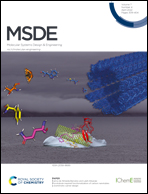Evaluation of plant-derived semi-synthetic molecules against BRD3-BD2 protein: a computational strategy to combat breast cancer†
Abstract
BRD3-BD2 protein belongs to the bromodomain and extra-terminal domain (BET) protein family. The over-expression of BRD3-BD2 protein contributes to the development of breast cancer by modulating the expression of many genes. In breast cancer cells, the estrogen receptor (ER) gene is overexpressed, which is facilitated by the recruitment of the H3K36 methyltransferase to the estrogen ER gene by the BRD3-BD2 protein. The inhibition of BRD3-BD2 protein suppresses the classical ER signaling pathway and inhibits the growth of cancer cells. Molecular docking and long-term molecular dynamics (MD) simulations were used to explore the binding mechanism and structural impact of aminoarylbenzosuberene (BCH) molecules on BRD3-BD2 protein. Our preliminary analysis revealed that BCH molecules interacted strongly with the BRD3-BD2 protein. These results were further supported and validated by various time-dependent MD-driven analyses. Therefore, we intend to suggest that BCH molecules could be used as potential therapeutic molecules against cancers associated with the overexpression of BRD3-BD2 protein. However, in vitro and in vivo investigations would be required to reinforce the finding.



 Please wait while we load your content...
Please wait while we load your content...